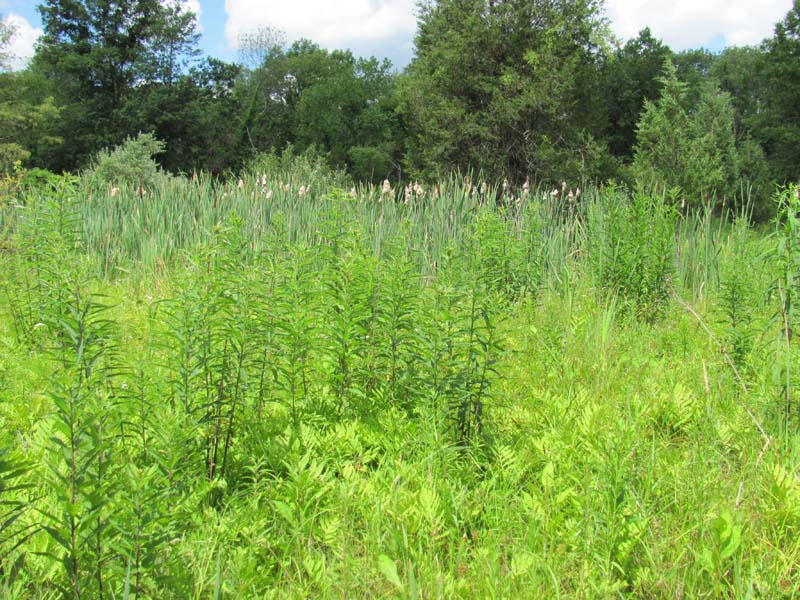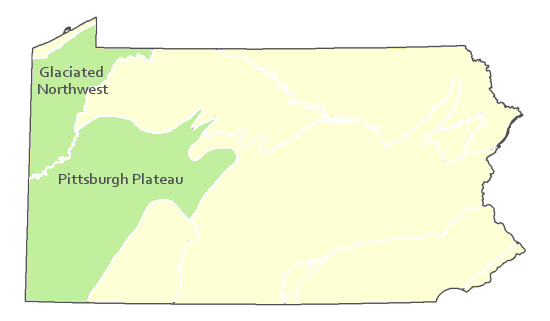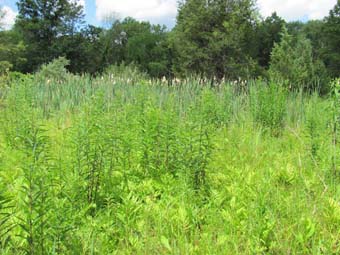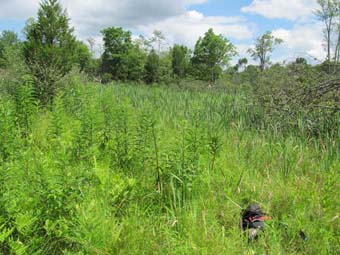Sedge – Mixed Forb Fen
System: Palustrine
Subsystem: Herbaceous
PA Ecological Group(s): Peatland Wetland
Global Rank:GNR
![]() rank interpretation
rank interpretation
State Rank: S1

General Description
These are open, sedge-dominated wetlands that usually occur on organic substrate (sedge peat), saturated throughout most of the year by base-rich groundwater. These sites usually lack the distinct seepage areas associated with other fen types. Sedge species dominate, including prairie sedge (Carex prairea), Atlantic sedge (Carex sterilis), and/or sedge (Carex tetanica). Other species may include mountain-mint (Pycnanthemum virginianum), blue vervain (Verbena hastata), starry false Solomon's-seal (Maianthemum stellatum), common cat-tail (Typha latifolia), willow-herb (Epilobium leptophyllum), bedstraw (Galium tinctorium), sensitive fern (Onoclea sensibilis), jewelweed (Impatiens capensis), swamp thistle (Cirsium muticum), and Greek valerian (Polemonium reptans).
Rank Justification
Critically imperiled in the jurisdiction because of extreme rarity or because of some factor(s) such as very steep declines making it especially vulnerable to extirpation from the jurisdiction.
Identification
- Presence of calcareous indicator plant species such as Atlantic sedge (Carex sterilis), sedge (Carex tetanica), and mountain-mint (Pycnanthemum virginianum)
- Peat is usually present.
- Dominance of grass-like plants
- Surface water pH is between 6.0 and 7.9 during the growing season.
Herbs
- Prairie sedge (Carex prairea)
- Atlantic sedge (Carex sterilis)
- Wood's sedge (Carex tetanica)
- Mountain-mint (Pycnanthemum virginianum)
- Blue vervain (Verbena hastata)
- Starflower (Maianthemum stellatum)
- Common cat-tail (Typha latifolia)
- Willow-herb (Epilobium leptophyllum)
- Bedstraw (Galium tinctorium)
- Sensitive fern (Onoclea sensibilis)
- Jewelweed (Impatiens capensis)
- Swamp thistle (Cirsium muticum)
- Spreading Jacob's-ladder (Polemonium reptans)
- Baltic rush (Juncus arcticus var. littoralis)
- Spotted joe-pye-weed (Eutrochium maculatum)
Exotic Species
* limited to sites with higher soil calcium
Vascular plant nomenclature follows Rhoads and Block (2007). Bryophyte nomenclature follows Crum and Anderson (1981).
International Vegetation Classification Associations:
USNVC Crosswalk:None
Representative Community Types:
Prairie Sedge - Tussock Sedge Fen (CEGL006551)
NatureServe Ecological Systems:
North-Central Appalachian Seepage Fen (CES202.607)
NatureServe Group Level:
None
Origin of Concept
Fike, J. 1999. Terrestrial and palustrine plant communities of Pennsylvania. Pennsylvania Natural Diversity Inventory. Pennsylvania Department of Conservation and Recreation, Bureau of Forestry, Harrisburg, PA. 86 pp.
Pennsylvania Community Code*
HO : Open Sedge (Carex Stricta, C. Prairea, C. Lacustris) Fen
*(DCNR 1999, Stone 2006)
Similar Ecological Communities
The Sedge – Mixed Forb Fen is distinguished from other groundwater-fed community types by presence of calciphilic species, shrub cover, or landscape position. Other basin-fen types fed by calcium-rich groundwater include the Poison Sumac - Red-cedar - Bayberry Fen and Alder-leaved Buckthorn – Inland Sedge – Golden Ragwort Shrub Fen, which differ from the Sedge – Mixed Forb Fen in that they exhibit a significantly higher shrub-cover. The Sedge – Mixed Forb Fen type, which is found primarily in basins or depressions, differs in landscape position from the Great Lakes Bluff Seep and River Bluff Seep, most often found on nearly vertical walls of tributary gorges and lake bluffs and This type is distinquished from the “poor fens” (Many-Fruited Sedge – Bladderwort Poor Fen, Cotton-grass Poor Fen) and other acidic peatlands by the presence and sometimes dominance of calciphilic species such as prairie sedge (Carex prairea), Atlantic sedge (Carex sterilis), sedge (Carex tetanica), and mountain-mint (Pycnanthemum virginianum). Tussock Sedge Marsh is strongly dominated by tussock sedge (Carex stricta). Bluejoint – Reed Canary-grass Marsh may contain tussock sedge, but it is dominated by bluejoint (Calamagrostis canadensis var. canadensis) and co-dominated by reed canary-grass (Phalaris arundinacea).
Fike Crosswalk
Open sedge (Carex stricta, C. prairea, C. lacustris) fen
Conservation Value
The Sedge – Mixed Forb Fen occurs in calcareous wetlands, which are especially unusual in Pennsylvania, where the predominant geology in most regions is acidic. There are a number of plants, aquatic invertebrates, and lepidopterans adapted specifically to this high-pH wetland habitat. Plants of special concern in Pennsylvania found in this habitat include prairie sedge (Carex prairea), sedge (Carex tetanica), and Schweinitz' sedge (Carex schweinitzii). These wetlands are irreplaceable, as their specific environmental conditions have formed over hundreds or thousands of years.
Threats
The greatest threats to these communities are disruptions to bedrock or glacial deposits such as drilling or mining in nearby areas and groundwater extraction, which can contaminate or alter the flow patterns of the groundwater that feeds the seepage. Groundwater pollution can also occur from improperly installed septic systems, from improperly lined underground waste disposal, and in agricultural areas, from infiltration of pesticides, fertilizer, and bacteria from animal wastes. Invasive plant species, such as common reed (Phragmites australis ssp. australis), can threaten the biological integrity of the community. Wetland soils and vegetation are sensitive and will be damaged by foot traffic or recreational vehicles as they are easily compacted.
Management
Drilling, mining, or other disruptions to bedrock or glacial deposits should not be undertaken within half a mile of a seepage wetland without a thorough understanding of bedrock layers and groundwater flows. Groundwater flow patterns do not always mirror surface watersheds, and in some cases aquifers may be contiguous over large areas. Seepage wetlands are also sensitive to trampling and other physical disturbance from recreational activities; trails should be sited away from the wetland, or elevated structures employed to prevent traffic in the wetland. A natural buffer around the wetland should be maintained in order to minimize nutrient runoff, pollution, and sedimentation. The potential for soil erosion based on soil texture, condition of the adjacent vegetation (mature forests vs. clearcuts), and the topography of the surrounding area (i.e., degree of slope) should be considered when establishing buffers. The buffer size should be increased if soils are erodible, adjacent vegetation has been logged, and the topography is steep as such factors could contribute to increased sedimentation and nutrient pollution. These wetlands may require periodic disturbance, such as burning or grazing, to maintain their open canopy which is indicative of the Sedge – Mixed Forb Fen and the rare species that occupy the community.
Research Needs
More site inventory and classification work is needed to refine the definition of this community type and resolve its relationship to other types. It appears that some of these wetlands will succeed to shrubland if not maintained. Management of these wetlands would be informed by an understanding of natural successional pathways, and of the historical frequency of disturbances such as fire and grazing in these wetlands.
Trends
Specific information on the loss and degradation of the Sedge – Mixed Forb Fen community is not available. However, most calcareous soils in Pennsylvania occur in valleys or glaciated regions that are also favorable for agriculture and settlement, and have been extensively cleared of natural vegetation for these purposes. Thus Sedge – Mixed Forb Fen wetlands, always few in number in Pennsylvania, are likely to have been lost or altered at a disproportionately high rate to other wetland types.
Range Map

Pennsylvania Range
NW and SW PA
Global Distribution
Pennsylvania
Byers, E. A., J. P. Vanderhorst, and B. P. Streets. 2007. Classification and conservation assessment of high elevation wetland communities in the Allegheny Mountains of West Virginia. West Virginia Natural Heritage Program, West Virginia Division of Natural Resources, Elkins.
CAP [Central Appalachian Forest Working Group]. 1998. Central Appalachian Working group discussions. The Nature Conservancy, Boston, MA.
Clancy, K. 1996. Natural communities of Delaware. Unpublished review draft. Delaware Natural Heritage Program, Division of Fish and Wildlife, Delaware Division of Natural Resources and Environmental Control, Smyrna, DE. 52 pp.
Cowardin, L. M., V. Carter, F. C. Golet, and E. T. LaRoe. 1979. Classification of wetlands and deepwater habitats of the United States. U.S. Fish and Wildlife Service, Biological Service Program. FWS/OBS-79/31. Washington, DC. 103 pp.
Dahl, T.E. 1990. Wetlands losses in the United States 1780's to 1980's. U.S. Department of the Interior, Fish and Wildlife Service. Washington, D.C. http://www.npwrc.usgs.gov/resource/othrdata/wetloss/wetloss.htm (Version 16JUL97).
Dahl, T.E. 2006. Status and trends of wetlands in the conterminous United States 1998 to 2004. U.S. Department of the Interior; Fish and Wildlife Service, Washington, D.C. 112 pp.
Eastern Ecology Working Group of NatureServe. No date. International Ecological Classification Standard: International Vegetation Classification. Terrestrial Vegetation. NatureServe, Boston, MA.
Edinger, G. J., D. J. Evans, S. Gebauer, T. G. Howard, D. M. Hunt, and A. M. Olivero, editors. 2002. Ecological communities of New York state. Second edition. A revised and expanded edition of Carol Reschke's ecological communities of New York state. (Draft for review). New York Natural Heritage Program, New York State Department of Environmental Conservation, Albany, NY.
Fike, J. 1999. Terrestrial and palustrine plant communities of Pennsylvania. Pennsylvania Natural Diversity Inventory. Pennsylvania Department of Conservation and Recreation. Bureau of Forestry. Harrisburg, PA. 86 pp.
Gawler, S. C. 2002. Natural landscapes of Maine: A guide to vegetated natural communities and ecosystems. Maine Natural Areas Program, Department of Conservation, Augusta, ME. [in press]
Harrison, J. W., compiler. 2004. Classification of vegetation communities of Maryland: First iteration. A subset of the International Classification of Ecological Communities: Terrestrial Vegetation of the United States, NatureServe. Maryland Natural Heritage Program, Maryland Department of Natural Resources, Annapolis. 243 pp.
Hill, A. F. 1923. The vegetation of the Penobscot Bay region, Maine. Proceedings of the Portland Society of Natural History 3:307-438.
NatureServe 2010. NatureServe Explorer: An online encyclopedia of life Version 7.1. NatureServe, Arlington, VA. Available http://www.natureserv.org/explorer (accessed: 23 November 2011).
Northern Appalachian Ecology Working Group. 2000. Northern Appalachian / Boreal Ecoregion community classification (Review Draft). The Nature Conservancy, Eastern Conservation Science Center, Boston, MA. 117 pp. plus appendices.
Pennsylvania Department of Conservation and Natural Resources (DCNR). 1999. Inventory Manual of Procedure. For the Fourth State Forest Management Plan. Pennsylvania Bureau of Forestry, Division of Forest Advisory Service. Harrisburg, PA. 51 ppg.
Sperduto, D. D. 2000b. A classification of wetland natural communities in New Hampshire. New Hampshire Natural Heritage Inventory, Department of Resources and Economic Development, Division of Forests and Lands. Concord, NH. 156 pp.
Stone, B., D. Gustafson, and B. Jones. 2006 (revised). Manual of Procedure for State Game Land Cover Typing. Commonwealth of Pennsylvania Game Commission, Bureau of Wildlife Habitat Management, Forest Inventory and Analysis Section, Forestry Division. Harrisburg, PA. 79 ppg.
Swain, P. C., and J. B. Kearsley. 2000. Classification of natural communities of Massachusetts. July 2000 draft. Natural Heritage and Endangered Species Program, Massachusetts Division of Fisheries and Wildlife. Westborough, MA.
Thompson, E. 1996. Natural communities of Vermont uplands and wetland. Nongame and Natural Heritage Program, Department of Fish and Wildlife in cooperation with The Nature Conservancy, Vermont chapter. 34 pp.
Thompson, E. H., and E. R. Sorenson. 2000. Wetland, woodland, wildland: A guide to the natural communities of Vermont. The Nature Conservancy and the Vermont Department of Fish and Wildlife. University Press of New England, Hanover, NH. 456 pp.
Tiner, R.W. 1990. Pennsylvania’s Wetlands: Current Status and Recent Trends. U. S. Fish and Wildlife Service report, 104 pp.
Cite as:
Mcpherson, J. 2022. Pennsylvania Natural Heritage Program. Sedge – Mixed Forb Fen Factsheet. Available from: https://naturalheritage.state.pa.us/Community.aspx?=16009 Date Accessed: August 22, 2025



 fen.jpg)





